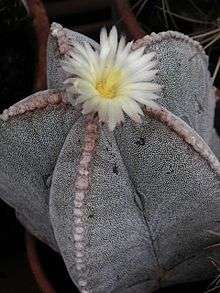Classification of the Cactaceae

In 1984, the International Organization for Succulent Plant Study set up a working party, now called the International Cactaceae Systematics Group, to produce a consensus classification of the cactus family, down to the level of genus. Their classification has been used as the basis for systems published since the mid-1990s. Treatments in the 21st century have generally divided the family into around 125–130 genera and 1,400–1,500 species, which are then arranged in a number of tribes and subfamilies. However, subsequent molecular phylogenetic studies have shown that a very high proportion of the higher taxa (genera, tribes and subfamilies) are not monophyletic, i.e. they do not contain all of the descendants of a common ancestor. As of March 2012, the internal classification of the family Cactaceae is uncertain and likely to change. A possible classification incorporating many of the insights from the molecular studies was produced by Nyffeler and Eggli in 2010.[1]
Introduction
The classification of the family Cactaceae remains uncertain as of March 2012. Since the mid-1990s, the system produced by the International Cactaceae Systematics Group (ICSG) of the International Organization for Succulent Plant Study has been used as the basis of many published classifications. Detailed treatments produced in the 21st century have divided the family into around 125–130 genera and 1,400–1,500 species, which are then arranged into a number of tribes and subfamilies.[2][3][4]
The ICSG classification of the family recognizes four subfamilies: Pereskoideae (consisting only of the genus Pereskia), Opuntioideae, Maihuenioideae (consisting only of the genus Maihuenia) and Cactoideae.[2] Molecular phylogenetic studies suggest that Pereskia is not monophyletic (i.e. its species are not the complete set of descendants of a common ancestor), although the three other subfamilies are.[4][5] The Bayesian consensus cladogram from a 2005 study is shown below:[5]
|
Pereskioideae |
Five tribes have been recognized within the subfamily Opuntioideae: Tephrocacteae, Pterocacteae, Austrocylindropuntieae, Cylindropuntieae and Opuntieae.[6] All but the first, Tephrocacteae, were shown to be "essentially monophyletic" in molecular phylogenetic study in 2009. A summary of the consensus Bayesian tree is shown below (tribes are bold; the number of species in the study is shown in parentheses).[7]
|
≈ Opuntieae |
Many of the genera within the Opuntioideae are not monophyletic. Maihueniopsis is highly polyphyletic, appearing in four separate lineages. The two largest genera within the subfamily, Opuntia and Cylindropuntia are also not monophyletic. The classification of the Opuntioideae is thus uncertain as of March 2012; Griffith and Porter say that changes in classification will require "broad information (of multiple data types) regarding all species of opuntioid cacti".[8]
The ICSG classification divides the subfamily Cactoideae into nine tribes. However, phylogenetic research has not supported most of these tribes, nor even the genera of which they are composed. A 2011 study found that "an extraordinarily high proportion of genera" were not monophyletic, including 22 (61%) of the 36 genera in the subfamily Cactoideae sampled in the research.[4] Of the nine tribes recognized within Cactoideae, one, Calymmantheae, comprises a single genus, Calymmanthium.[2] Of the remaining eight, only two (Cacteae and Rhipsalideae) have been shown to be monophyletic. A summary of the cladograms for the Cactoideae presented in a 2011 paper is shown below (ICSG tribes in bold).[9]
| Cactoideae |
| ||||||||||||||||||||||||||||||
| |
The classification of genera and tribes in the Cactaceae is thus likely to change in future.
Classification
Unless otherwise indicated, the subfamily placement of the genera listed here is based on Anderson's 2001 presentation of the ICSG classification, as is the tribal placement of the genera of the subfamily Cactoideae.[10] The division of the subfamily Opuntioideae into tribes is additional to the ICSG system.[6][11]
Subfamily Pereskioideae

- Pereskia Mill.
- synonyms: Peirescia Zucc. (orth. var.), Peireskia Steud. (orth. var.), Perescia Lem. (orth. var.), Rhodocactus (A.Berger) F.M.Knuth
Subfamily Opuntioideae
Tribe Austrocylindropuntieae
- Austrocylindropuntia Backeb.
- Cumulopuntia F.Ritter
Tribe Cylindropuntieae
- Cylindropuntia (Engelm.) F.M.Knuth – chollas
- Grusonia F.Rchb. ex Britton & Rose
- including Corynopuntia F.M.Knuth, Micropuntia Daston
- Pereskiopsis Britton & Rose
- synonyms: Peireskiopsis Vaupel (orth. var.)
- Quiabentia Britton & Rose
Tribe Opuntieae
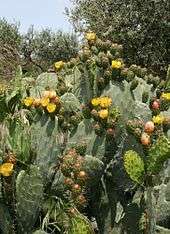
- Brasiliopuntia (K.Schum.) A.Berger
- Consolea Lem.
- Miqueliopuntia Fric ex F.Ritter
- Opuntia Mill. – prickly pears
- synonyms:Airampoa Fric, Cactodendron Bigelow, nom. inval., Cactus Lem., Chaffeyopuntia Fric & Schelle, Clavarioidia Kreuz. (nom. inval.), Ficindica St.-Lag., Nopalea Salm-Dyck, Parviopuntia Soulaire & Marn.-Lap. (nom. inval.), Phyllarthus Neck. ex M.Gómez (nom. inval.), Salmiopuntia Fric (nom. inval.), Subulatopuntia Fric & Schelle, Tunas Lunell, Weberiopuntia Fric
- including Nopalea Salm-Dyck
Tribe Pterocacteae
- Pterocactus K.Schum.
Tribe Tephrocacteae
- Maihueniopsis Speg.
- including Puna R.Kiesling
- Tephrocactus Lem.
- synonyms: Pseudotephrocactus Fric
Subfamily Maihuenioideae
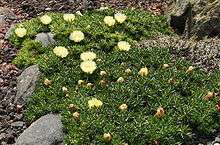
- Maihuenia (Phil. ex F.A.C.Weber) K.Schum.
Subfamily Cactoideae
Tribe Browningieae
- Armatocereus Backeb.
- Browningia Cárdenas, Gymnocereus Rauh & Backeb.
- Jasminocereus Britton & Rose
- Neoraimondia Britton & Rose
- synonyms: Neocardenasia Backeb.
- Stetsonia Britton & Rose
Tribe Cacteae
- Acharagma (N.P.Taylor) Glass
- AriocarpusScheidw. – living rock
- synonyms: Anhalonium Lem., Neogomesia Castañeda, Neogomezia Buxb. (orth. var.), Roseocactus A.Berger, Stromatocactus Karw. ex Rümpler (nom. inval.)
- Astrophytum Lem.
- synonyms: Astrophyton Lawr. (orth. var.), Maierocactus E.C.Rost
- Aztekium Boed.
- Cochemiea (K.Brandegee) Walton – see Mammillaria
- Coryphantha (Engelm.) Lem. – beehive cactus
- synonyms: Aulacothele Monv. (nom. inval.), Cumarinia Buxb., Glandulifera (Salm-Dyck) Fric, Lepidocoryphantha Backeb., Roseia Fric (nom. inval.)
- Echinocactus Link & Otto – barrel cactus
- synonyms: Brittonrosea Speg., Echinofossulocactus Lawr., Homalocephala Britton & Rose
- Echinomastus Britton & Rose
- Epithelantha F.A.C.Weber ex Britton & Rose – pingpong ball cactus
- Escobaria Britton & Rose – foxtail cactus, pincushion cactus
- synonyms: Cochiseia W.H.Earle, Escobesseya Hester, Fobea Fric (nom. inval.), Neobesseya Britton & Rose
- Ferocactus Britton & Rose – barrel cactus
- synonyms: Bisnaga Orcutt, Brittonia C.A.Armstr. (nom. inval.)
- Geohintonia Glass & W.A.Fitz Maur.
- Leuchtenbergia Hook.
- Lophophora J.M.Coult. – peyote
- Mammillaria Haw. – fishhook cactus, globe cactus, pincushion cactus, bird's-nest cactus
- synonyms: Bartschella Britton & Rose, Cactus L., Chilita Orcutt, Cochemiea (K.Brandegee) Walton, Dolichothele (K.Schum.) Britton & Rose, Ebnerella Buxb., Haagea Fric, Krainzia Backeb., Lactomammillaria Fric (nom. inval.), Leptocladia Buxb., Leptocladodia Buxb., Mamillaria F.Rchb. (orth. var.), Mamillopsis (E.Morren) F.A.C.Weber ex Britton & Rose, Mammariella Shafer (nom. inval.), Mammilaria Torr. & A.Gray (orth. var.), Neomammillaria Britton & Rose, Oehmea Buxb., Phellosperma Britton & Rose, Porfiria Boed., Pseudomammillaria Buxb., Solisia Britton & Rose
- Mammilloydia Buxb.
- Neolloydia Britton & Rose
- synonyms: Napina Fric (nom. inval.), Pseudosolisia Y.Itô (nom. inval.)
- Obregonia Fric
- Ortegocactus Alexander
- Pediocactus Britton & Rose – hedgehog cactus
- synonyms: Navajoa Croizat, Pilocanthus B.W.Benson & Backeb.
- Pelecyphora C.Ehrenb.
- synonyms: Encephalocarpus A.Berger
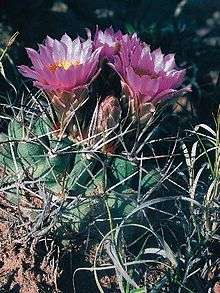
- Sclerocactus Britton & Rose – fishhook cactus
- synonyms: Ancistrocactus Britton & Rose, Coloradoa Boissev. & C.Davidson, Glandulicactus Backeb., Toumeya Britton & Rose
- Stenocactus (K.Schum.) A.W.Hill
- synonyms: Echinofossulocactus Britton & Rose, Efossus Orcutt (orth. var.)
- Strombocactus Britton & Rose
- Thelocactus (K.Schum.) Britton & Rose
- synonyms: Hamatocactus Britton & Rose, Thelomastus Fric (nom. inval.)
- Turbinicarpus (Backeb.) Buxb. & Backeb. – top cactus
- synonyms: Gymnocactus Backeb., Normanbokea Kladiwa & Buxb., Rapicactus Buxb. & Oehme
Tribe Calymmantheae
- synonyms: Diploperianthium F.Ritter (nom. inval.)
Tribe Cereeae
- Arrojadoa Britton & Rose
- synonyms: Pierrebraunia Esteves
- Brasilicereus Backeb.
- Cereus Mill. – sweet potato cactus
- synonyms: Mirabella F.Ritter, Piptanthocereus (A.Berger) Riccob., Subpilocereus Backeb.
- Cipocereus F.Ritter
- synonyms: Floribunda F.Ritter
- Coleocephalocereus Backeb.
- synonyms: Buiningia Buxb.
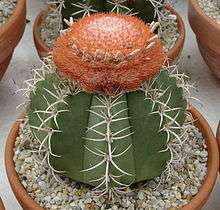
- Melocactus Link & Otto
- synonyms: Cactus Britton & Rose
- Micranthocereus Backeb.
- synonyms: Austrocephalocereus Backeb., Siccobaccatus P.J.Braun & Esteves
- Pilosocereus Byles & G. D. Rowley – tree cactus
- synonyms: Pilocereus K.Schum., Pseudopilocereus Buxb.
- Praecereus Buxb.
- Stephanocereus A.Berger
- Uebelmannia Buining
Tribe Hylocereeae
- synonyms: Aporocactus Lem., Aporocereus Fric & Kreuz. (orth. var.), Bonifazia Standl. & Steyerm., Chiapasia Britton & Rose, Disisocactus Kunze (orth. var.), Disocereus Fric & Kreuz. (orth. var.), Heliocereus (A.Berger) Britton & Rose, Lobeira Alexander, Mediocereus Fric & Kreuz. (orth. var.), Nopalxochia Britton & Rose, Pseudonopalxochia Backeb., Trochilocactus Linding., Wittia K.Schum., Wittiocactus Rauschert
_91b.jpg)
- Epiphyllum Haw. – climbing cactus
- synonyms: Phyllocactus Link, Phyllocereus Miq.
- Hylocereus (A.Berger) Britton & Rose – nightblooming cactus
- synonyms: Wilmattea Britton & Rose
- Pseudorhipsalis Britton & Rose
- Selenicereus (A.Berger) Britton & Rose – moonlight cactus, nightblooming cereus
- synonyms: Cryptocereus Alexander, Deamia Britton & Rose, Marniera Backeb., Mediocactus Britton & Rose, Strophocactus Britton & Rose, Strophocereus Fric & Kreuz. (orth. var.)
- Weberocereus Britton & Rose
- synonyms: Eccremocactus Britton & Rose, Eccremocereus Fric & Kreuz. (orth. var.), Werckleocereus Britton & Rose
Tribe Notocacteae
- Austrocactus Britton & Rose
- Blossfeldia Werderm.
- Cintia Knize & Ríha
- Copiapoa Britton & Rose
- synonyms: Pilocopiapoa F.Ritter
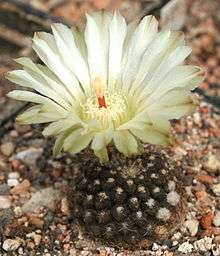
- synonyms: Ceratistes Labour. (nom. inval.), Chileniopsis Backeb., Chileocactus Fric (nom. inval.), Chileorebutia Fric (nom. inval.), Chiliorebutia Fric (orth. var.), Delaetia Backeb., Dracocactus Y.Itô (nom. inval.), Euporteria Kreuz. & Buining, Hildmannia Kreuz. & Buining, Horridocactus Backeb., Islaya Backeb., Neochilenia Backeb. ex Dölz, Neoporteria Britton & Rose, Neoporteria Backeb., Neotanahashia Y.Itô, Nichelia Bullock (nom. inval.), Pyrrhocactus (A.Berger) A.W.Hill, Rodentiophila F.Ritter ex Backeb., Thelocephala Y.Itô
- Eulychnia Phil.
- synonyms: Philippicereus Backeb.
- Frailea Britton & Rose
- Neowerdermannia Fric
- Parodia Speg.
- synonyms: Acanthocephala Backeb., Brasilicactus Backeb., Brasiliparodia F.Ritter, Brasilocactus Fric (nom. inval.), Chrysocactus Y.Itô (nom. inval.), Dactylanthocactus Y.Itô, Eriocactus Backeb., Eriocephala Backeb., Friesia Fric (nom. inval.), Hickenia Britton & Rose, Malacocarpus Salm-Dyck, Microspermia Fric, Neohickenia Fric, Notocactus (K.Schum.) Fric, Sericocactus Y.Itô, Wigginsia D.M.Porter
Tribe Pachycereeae
- Acanthocereus (Engelm. ex A.Berger) Britton & Rose – triangle cactus
- synonyms: Dendrocereus Britton & Rose, Monvillea Britton & Rose
- Bergerocactus Britton & Rose – snake cactus
- synonyms: Bergerocereus Fric & Kreuz. (orth. var.)
- Carnegiea Britton & Rose – saguaro
- Cephalocereus Pfeiff. – old man cactus
- synonyms: Haseltonia Backeb., Neodawsonia Backeb., Pilocereus Lem.
- Corryocactus Britton & Rose
- synonym: Corryocereus Fric & Kreuz. (orth. var.), Erdisia Britton & Rose, Eulychnocactus Backeb. (nom. inval.)
- Dendrocereus Britton & Rose – see Acanthocereus
- Echinocereus Engelm. – hedgehog cactus
- synonyms: Morangaya G.D.Rowley, Wilcoxia Britton & Rose
- Escontria Rose
- Isolatocereus Backeb. – see Stenocereus
- Leptocereus (A.Berger) Britton & Rose
- synonyms: Neoabbottia Britton & Rose
- [= Myrtillocactus × Bergerocactus]
- Myrtillocactus Console
- synonyms: Myrtillocereus Fric & Kreuz. (orth. var.)

- Neobuxbaumia Backeb.
- synonyms: Pseudomitrocereus Bravo & Buxb., Rooksbya Backeb.
- ×Pacherocactus G.D.Rowley
- [= Pachycereus × Bergerocactus]
- Pachycereus (A.Berger) Britton & Rose
- synonyms: Backebergia Bravo, Lemaireocereus Britton & Rose, Lophocereus (A.Berger) Britton & Rose, Marginatocereus (Backeb.) Backeb., Mitrocereus (Backeb.) Backeb., Pterocereus T.MacDoug. & Miranda
- Peniocereus (A.Berger) Britton & Rose
- synonyms: Cullmannia Distefano, Neoevansia W.T.Marshall, Nyctocereus (A.Berger) Britton & Rose
- Polaskia Backeb.
- synonyms: Chichipia Backeb. (nom. inval.), Heliabravoa Backeb.
- Pseudoacanthocereus F.Ritter
- Stenocereus (A.Berger) Riccob.
- synonyms: Hertrichocereus Backeb., Isolatocereus Backeb., Isolatocereus (Backeb.) Backeb., Machaerocereus Britton & Rose, Marshallocereus Backeb., Neolemaireocereus Backeb., Rathbunia Britton & Rose, Ritterocereus Backeb.
Tribe Rhipsalideae

- Hatiora Britton & Rose
- synonyms: Epiphyllopsis Backeb. & F.M.Knuth, Hariota DC., Pseudozygocactus Backeb., Rhipsalidopsis Britton & Rose
- Lepismium Pfeiff.
- synonyms: Acanthorhipsalis (K.Schum.) Britton & Rose, Acanthorhipsalis Kimnach, Pfeiffera Salm-Dyck
- synonyms: Cassytha Mill., Erythrorhipsalis A.Berger, Hariota Adans., Lymanbensonia Kimnach
- Schlumbergera Lem. – Christmas cactus, Easter cactus
- synonyms: Epiphyllanthus A.Berger, Epiphyllum Pfeiff., Opuntiopsis Knebel (nom. inval.), Zygocactus K.Schum., Zygocereus Fric & Kreuz. (orth. var.)
Tribe Trichocereeae
- Acanthocalycium Backeb.
- synonyms: Spinicalycium Fric (nom. inval.)
- Arthrocereus A.Berger
- Brachycereus Britton & Rose
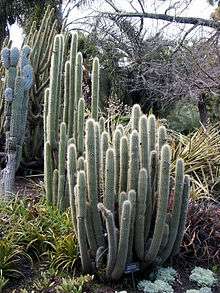
- Cleistocactus Lem.
- synonyms: Akersia Buining, Bolivicereus Cárdenas, Borzicactella H.Johnson ex F.Ritter, Borzicactus Riccob, Borzicereus Fric & Kreuz. (orth. var.), Cephalocleistocactus F.Ritter, Cleistocereus Fric & Kreuz. (orth. var.), Clistanthocereus Backeb., Demnosa Fric, Gymnanthocereus Backeb., Hildewintera F.Ritter, Loxanthocereus Backeb., Maritimocereus Akers, Pseudoechinocereus Buining (nom. inval.), Seticereus Backeb., Seticleistocactus Backeb., Winteria F.Ritter, Winterocereus Backeb.
- Cephalocleistocactus F.Ritter – see Cleistocactus
- Denmoza Britton & Rose
- Discocactus Pfeiff.
- Echinopsis Zucc. – San Pedro cactus
- synonyms: Acantholobivia Backeb., Acanthopetalus Y.Itô, Andenea Fric (nom. inval.), Aureilobivia Fric, nom. inval., Chamaecereus Britton & Rose, Chamaelobivia Y. Itô (nom. inval.), Cinnabarinea Fric ex F.Ritter, Echinolobivia Y.Itô (nom. inval.), Echinonyctanthus Lem., Furiolobivia Y.Itô (nom. inval.), Helianthocereus Backeb, Heterolobivia Y.Itô (nom. inval.), Hymenorebulobivia Fric (nom. inval.), Hymenorebutia Fric ex Buining, Leucostele Backeb., Lobirebutia Fric (nom. inval.), Lobivia Britton & Rose, Lobiviopsis Fric (nom. inval.), Megalobivia Y.Itô (nom. inval.), Mesechinopsis Y.Itô, Neolobivia Y.Itô, Pilopsis Y.Itô (nom. inval.), Pseudolobivia (Backeb.) Backeb., Rebulobivia Fric (nom. inval.), Salpingolobivia Y.Itô, Scoparebutia Fric & Kreuz. ex Buining, Setiechinopsis (Backeb.) de Haas, Soehrensia Backeb., Trichocereus (A.Berger) Riccob.
- Espostoa Britton & Rose
- synonyms: Binghamia Britton & Rose, Pseudoespostoa Backeb., Thrixanthocereus Backeb., Vatricania Backeb.
- Espostoopsis Buxb.
- synonyms: Gerocephalus F.Ritter
- Facheiroa Britton & Rose
- synonyms: Zehntnerella Britton & Rose

- Gymnocalycium Pfeiff. ex Mittler – chin cactus
- synonyms: Brachycalycium Backeb.
- Haageocereus Backeb.
- synonyms: Floresia Krainz & F.Ritter ex Backeb. (nom. inval.), Haageocactus Backeb. (nom. inval.), Lasiocereus F.Ritter, Neobinghamia Backeb., Peruvocereus Akers
- ×Haagespostoa G.D.Rowley
- [= Haageocereus × Espostoa]
- Harrisia Britton – apple cactus
- synonyms: Eriocereus (A.Berger) Riccob., Roseocereus Backeb.
- Lasiocereus F.Ritter – see Haageocereus
- Leocereus Britton & Rose
- Matucana Britton & Rose
- synonyms: Eomatucana F.Ritter
- Mila Britton & Rose
- Oreocereus (A.Berger) Riccob.
- synonyms: Arequipa Britton & Rose, Arequipiopsis Kreuz. & Buining, Morawetzia Backeb., Submatucana Backeb.
- Oroya Britton & Rose
- Pygmaeocereus H.Johnson & Backeb.
- Rauhocereus Backeb.

- Rebutia K.Schum.
- synonyms: Aylostera Speg., Bridgesia Backeb., Cylindrorebutia Fric & Kreuz., Digitorebutia Fric & Kreuz., Echinorebutia Fric (nom. inval.), Eurebutia Fric (nom. inval.), Gymnantha Y.Itô, Mediolobivia Backeb., Mediorebutia Fric (nom. inval.), Neogymnantha Y.Itô, Reicheocactus Backeb., Setirebutia Fric & Kreuz. (nom. inval.), Spegazzinia Backeb., Sulcorebutia Backeb., Weingartia Werderm.
- Samaipaticereus Cárdenas
- Weberbauerocereus Backeb.
- synonyms: Meyenia Backeb.
- Yungasocereus F.Ritter
Notes and references
- ↑ Nyffeler, R. & Eggli, U. (2010), "A farewell to dated ideas and concepts: molecular phylogenetics and a revised suprageneric classification of the family Cactaceae", Schumannia, 6: 109–149, doi:10.5167/uzh-43285
- 1 2 3 Anderson 2001, pp. 99–103
- ↑ Hunt, D.R., ed. (2006), The New Cactus Lexicon (two volumes), Milborne Port: dh books, ISBN 978-0-9538134-4-5, cited in Bárcenas, Yesson & Hawkins 2011
- 1 2 3 Bárcenas, Rolando T.; Yesson, Chris & Hawkins, Julie A. (2011), "Molecular systematics of the Cactaceae", Cladistics, 27 (5): 470–489, doi:10.1111/j.1096-0031.2011.00350.x
- 1 2 Edwards, Erika J.; Nyffeler, Reto & Donoghue, Michael J. (2005), "Basal cactus phylogeny: implications of Pereskia (Cactaceae) paraphyly for the transition to the cactus life form", American Journal of Botany, 92 (7): 1177–1188, doi:10.3732/ajb.92.7.1177
- 1 2 Wallace, R.S. & Dickie, S.L. (2002), "Systematic implication of chloroplast DNA sequence variation in subfam. Opuntioideae (Cactaceae)", Succulent Plant Research, 6: 9–24, cited in Griffith & Porter 2009
- ↑ Griffith, M. Patrick & Porter, J. Mark (2009), "Phylogeny of Opuntioideae (Cactaceae)", International Journal of Plant Sciences, 170 (1): 107–116, doi:10.1086/593048. Tree based on fig. 1 with tribes from fig. 2.
- ↑ Griffith & Porter 2009, p. 114
- ↑ Hernández-Hernández, Tania; Hernández, Héctor M.; De-Nova, J. Arturo; Puente, Raul; Eguiarte, Luis E. & Magallón, Susana (2011), "Phylogenetic relationships and evolution of growth form in Cactaceae (Caryophyllales, Eudicotyledoneae)", American Journal of Botany, 98 (1): 44–61, doi:10.3732/ajb.1000129
- ↑ Anderson 2001, pp. 100–103
- ↑ "Family: Cactaceae Juss., nom. cons. subfam. Opuntioideae", Germplasm Resources Information Network, United States Department of Agriculture, 2004-02-13, retrieved 2012-03-26
- ↑ Kiesling, R. & Ferrari, O. (2003), "Yavia cryptocarpa – conservation action on a new and interesting cactus", British Cactus and Succulent Journal, 21 (1): 20–25
Bibliography
- Anderson, Edward F. (2001), The Cactus Family, Pentland, Oregon: Timber Press, ISBN 978-0-88192-498-5
